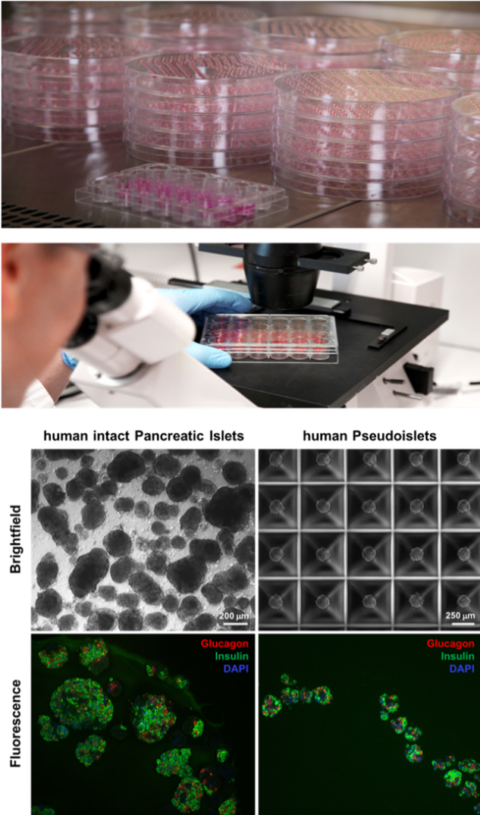Kontaktadresse
Universitätsspital Zürich
Klinik für Endokrinologie, Diabetologie
und Klinische Ernährung
Constanze Hantel
Rämistrasse 100
8091 Zürich
Wir untersuchen Funktion und Überleben von Inseln unter verschiedenen Bedingungen, entwickeln neuartige Platten zur Herstellung sogenannter «Pseudoislets» und testen innovative Scaffold-basierte Screening-Plattformen.
Am Universitätsspital Zürich wurde im Januar 2000 mit der Isolation von menschlichen Pankreasinseln begonnen und Ende Juni 2000 die erste Transplantation bei einem Patienten mit Typ 1 Diabetes durchgeführt. Im Rahmen dieses Programms wurde in enger Zusammenarbeit mit dem Departement für Viszeralchirurgie versucht, das Überleben von Inseln nach der Transplantation in die Leber zu verbessern und physiologische Regulation und Expression von Transkriptionsfaktoren, Hormonen und Enzymen in Pankreasinseln zu erforschen. Schwerpunkte waren hierbei: Funktion und Überleben von Inseln unter Hypoxiebedingungen, Einfluss der Grösse der Inseln auf Apoptose und Funktion, Einfluss von Transkriptionsfaktoren (HIF-1a) auf Apoptose und Dissoziation von intakten Inseln und Reaggreation in kleine Inseln definierter Grösse mit Hilfe der „Hanging Drop Technologie“, sowie mit eigens entwickelten Platten zur Herstellung von Pseudoinseln.
Kürzlich wurde ein neues, von der EU-gefördertes, Verbundprojekt in diesem Forschungsbereich initiiert. Unter dem Namen «Cells in Matrix» forschen hier hochrangige Ärzte und Naturwissenschaftler aus Israel, Deutschland und der Schweiz an der Entwicklung und Testung neuartiger Scaffold-basierter Plattformen zur Entwicklung von Mikro-Pankreata.

Structural and functional characterization of human pancreatic pseudoislets
Rejection and hypoxia are the main factors limiting islet engraftment in the liver of the recipient in the immediate posttransplant period. We could show a negative relationship between graft function and islets size concluding that small islets are superior to large islets. It has also been shown in animals that transplants with small islets achieve a better outcome than transplants with large islets. In humans, the size of the isolated islets for transplantation depends primarily on the organ donor and can only be influenced only to a very limited extent by the isolation itself. However, islets can be dissociated into single cells and reaggregated into so-called „pseudoislets“ of defined sizes by the „hanging-drop“ method or by reaggregation in specially designed microwells. We developed a clinically relevant plate with microwells that allows to vary the size of the pseudoislets, to standardize and to scale the number of pseudoislets from bench to bedside. We are improving the reaggregation procedure and evaluating which size of pseudoislets results in the best function, the highest glucose-stimulated insulin secretion and the best survival under hypoxic conditions equal to the conditions for the transplanted islets in the first few days after transplantation into the liver. Furthermore, we investigate whether the enhanced secretory function by controlled reaggregation leads to a reduced intra-donor variability.
The demand for diabetes drugs keeps increasing as adult diabetes prevalence is estimated to have risen to 629 million by 2045. There is an urgent need for more effective diabetes medications, which is complicated by the poor predictability of current models in the identification of lead compounds during drug discovery. The “Cells in Matrix” consortium kicked off the project in march 2020 and is funded by the EU with more than € 2 600 000 for the development of ‚engineered micro pancreas‘ (EMP), a 3D model for the R&D of diabetes drugs. It is based on an organ-derived 3D cell culture and human insulin-producing cells and will offer acceleration and cost reduction in diabetes drug development. The EMP system offers extended shelf life and function for in-depth studies on drug molecules‘ mode of action, validation, toxicology and in vitro pharmacokinetics, enabling higher predictability and reliability.
Universitätsspital Zürich
Klinik für Endokrinologie, Diabetologie
und Klinische Ernährung
Constanze Hantel
Rämistrasse 100
8091 Zürich
Betalin Therapeutics, Israel
CEO: Dr. Nikolai Kunicher
Technische Universität Dresden
Prof. Dr. med. Stefan Bornstein
Prof. Dr. med. Barbara Ludwig
Kugelmeiers AG, Switzerland
CEO: Patrick Kugelmeier
USZ/ENK
Prof. Dr. med. Felix Beuschlein
Horizon 2020 – EU-FTI „Cells in Matrix“